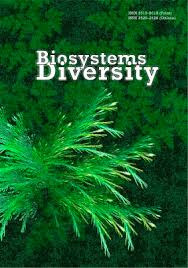Anthropogenic load іs a leading factor in the morphological variability of Chondrula tridens (Gastropoda, Enidae) in the northwestern Azov Sea region
Anthropogenic load іs a leading factor in the morphological variability of Chondrula tridens (Gastropoda, Enidae) in the northwestern Azov Sea region
Author(s): O. I. Koshelev, M. V. Gensytskyi, V. O. Koshelev, N. V. Yorkina, O. M. KunakhSubject(s): Geography, Regional studies, Energy and Environmental Studies, Sociobiology
Published by: Дніпропетровський національний університет імені Олеся Гончара
Keywords: terrestrial mollusks; variability; conchological characteristics; morphometric analysis;
Summary/Abstract: Morphometric data are widely used in biology to assess intraspecific and inter-population variability and for bioindication and environmental condition assessment. The following hypotheses have been experimentally tested in the paper: 1) the vegetation type affects the change in the shell shape of Chondrula tridens martynovi Gural-Sverlova & Gural, 2010; 2) the change in the shell shape of this species is influenced by the biotope moisture regime; 3) the shell shape changes depending on the anthropogenic load level. The material in the form of empty, fully formed Ch. tridens shells was collected in 2019 in the north-western Azov region within the basin of the Molochna River. The collection points were located in settlements and outside them and differed in vegetation, moisture regime and level of anthropogenic load. The vegetation has been expertly attributed to two alternative types: herbaceous vegetation and tree plantations. By moisture level, the locations have been assessed as xerophytic and mesoxerophytic. The anthropogenic load levels have been assessed as low, medium and high. The study revealed that the morphological characteristics of Ch. tridens demonstrate a significant component of variability, which is due to the shell size. The shell size depends on the anthropogenic impact level. Under conditions of high anthropogenic impact, the shell size increases. Mollusks from locations with low and medium anthropogenic impact levels did not differ in shell size. After extraction of the size component, morphological properties develop three main trends of variability. The mouth apparatus development of mollusks does not depend on the vegetation type, but depends on the biotope moisture level and the anthropogenic transformation level. The mollusk shell elongation was observed to have the opposite dynamics of the height parameters in relation to the width and depended on the level of anthropogenic load. Rearrangement in the mouth apparatus depended on the biotope moisture level and the anthropogenic load level. There were distinguished four clusters, the quantitative morphological features of which allowed us to identify them as morphotypes. Each location was characterized by a combination of different morphotypes, according to which the sampling points may be classified. Morphotype 1 corresponds to biotopes with low level of anthropogenic load, morphotype 4 corresponded to biotopes with high anthropogenic load. Morphotypes 2 and 3 corresponded to moderate level of anthropogenic load. Vegetation type is not an important factor in determining the morphotypic diversity of populations. Under xerophytic conditions, morphotypes 2 and 3 are more common, and under mesoxerophytic conditions, morphotypes 1 and 4 are more common. The range of molluscs in different habitats needs to be expanded in the future to clarify climatic and other patterns.
Journal: Biosystems Diversity
- Issue Year: 29/2021
- Issue No: 2
- Page Range: 102-110
- Page Count: 9
- Language: English

